Rate-Dependent Tensile Properties of Aluminum-Hydroxide-Enhanced Ethylene Propylene Diene Monomer Coatings for Solid Rocket Motors
Abstract
:1. Introduction
2. Materials and Methods
2.1. Materials and Specimens
2.2. Quasi-Static Experiments
2.3. Dynamic Experiments
3. Results and Discussion
3.1. Data Validation of Dynamic Experiments
3.2. Stress–Strain Results
4. Tensile Constitutive Model
4.1. Nonlinear Viscoelastic Constitutive Model
4.2. Hyper-Viscoelastic Constitutive Model
4.3. Constitutive Model of EPDM Coating
5. Model Construction and Verification
5.1. Parameter Calibration
5.2. Model Validation
6. Conclusions
Author Contributions
Funding
Institutional Review Board Statement
Informed Consent Statement
Data Availability Statement
Acknowledgments
Conflicts of Interest
References
- Ahmed, A.F.; Hoa, S.V. Thermal Insulation by Heat Resistant Polymers for Solid Rocket Motor Insulation. J. Compos. Mater. 2012, 46, 1549–1559. [Google Scholar] [CrossRef]
- Amado, J.C.Q.; Ross, P.G.; Sanches, N.B.; Pinto, J.R.A.; Dutra, J.C.N. Evaluation of Elastomeric Heat Shielding Materials as Insulators for Solid Propellant Rocket Motors: A Short Review. Open Chem. 2020, 18, 1452–1467. [Google Scholar] [CrossRef]
- Wei, B.; Yu, C.; Bai, Y.; Liu, L.; He, J. Preparation Optimization of CFRP and EPDM Composite by the Co-Curing Method. Materials 2023, 16, 503. [Google Scholar] [CrossRef] [PubMed]
- George, K.; Panda, B.P.; Mohanty, S.; Nayak, S.K. Recent Developments in Elastomeric Heat Shielding Materials for Solid Rocket Motor Casing Application for Future Perspective. Polym. Adv. Technol. 2018, 29, 8–21. [Google Scholar] [CrossRef]
- Sureshkumar, M.S.; Bhuvaneswari, C.M.; Kakade, S.D.; Gupta, M. Studies on the Properties of EPDM–CSE Blend Containing HTPB for Case-bonded Solid Rocket Motor Insulation. Polym. Adv. Technol. 2008, 19, 144–150. [Google Scholar] [CrossRef]
- Bhuvaneswari, C.M.; Sureshkumar, M.S.; Kakade, S.D.; Gupta, M. Ethylene-Propylene Diene Rubber as a Futuristic Elastomer for Insulation of Solid Rocket Motors. Def. Sci. J. 2006, 56, 309. [Google Scholar] [CrossRef]
- Liu, Y.; Li, X.; Zhu, P.; Xi, K. Ablation Characteristics of Insulator under High-Temperature Gas Dual-Pulse Erosion. Def. Technol. 2022, 18, 1875–1885. [Google Scholar] [CrossRef]
- Ye, Q.; Yu, Y.; Li, W. Study on Cook-off Behavior of HTPE Propellant in Solid Rocket Motor. Appl. Therm. Eng. 2020, 167, 114798. [Google Scholar] [CrossRef]
- Jiang, C.; Jin, Y.; Gao, J. Ablation and Thermal Insulation Properties of Silicone Rubber-Polyarylacetylene-Carbonwoven Laminates for Solid Rocket Motor. Plast. Rubber Compos. 2021, 50, 362–369. [Google Scholar] [CrossRef]
- Wang, J.; Cao, P.; Wang, X. Review of the Mechanical Properties and Numerical Simulation of Composite Solid Propellants. Materials 2023, 16, 6875. [Google Scholar] [CrossRef] [PubMed]
- Marimuthu, R.; Nageswara Rao, B. Development of Efficient Finite Elements for Structural Integrity Analysis of Solid Rocket Motor Propellant Grains. Int. J. Press. Vessels Pip. 2013, 111–112, 131–145. [Google Scholar] [CrossRef]
- Wang, R.; Wang, N.; Gao, J.; Zhang, Y.; Zhang, A.; Wu, Y. Friction-Induced Ignition Study of HTPB Propellant Based on a Coupled Chemo-Mechano-Thermodynamic Model under Ultrahigh Acceleration Overload Conditions. Case Stud. Therm. Eng. 2023, 52, 103708. [Google Scholar] [CrossRef]
- Pei, S.; Qiang, H.; Wang, X.; Li, S. Mesoscopic Failure Behavior of HTPB Propellant Bonding Interface under Multi-Angle Pull-and-Shear Loading. Polym. Test. 2024, 132, 108365. [Google Scholar] [CrossRef]
- Zhang, Y.; Wang, N.; Ma, W.; Wang, R.; Bai, L.; Wu, Y. Investigations of the Mechanical Response of Dummy HTPB Propellant Grain under Ultrahigh Acceleration Overload Conditions Using Onboard Flight-Test Measurements. Def. Technol. 2024, 32, 473–484. [Google Scholar] [CrossRef]
- Liu, H.; Wang, J.; Fu, X. Research on Crack Propagation of Nitrate Ester Plasticized Polyether Propellant: Experiments and Simulation. Materials 2024, 17, 2180. [Google Scholar] [CrossRef] [PubMed]
- George, K.; Panda, B.P.; Biswal, M.; Mohanty, S.; Nayak, S.K. Ethylene Propylene Diene Monomer Rubber-Based Heat Shielding Materials for Solid Rocket Motor: Impact of Kevlar Fiber Reinforcement on the Thermal and Mechanical Properties. Polym. Adv. Technol. 2020, 31, 1280–1290. [Google Scholar] [CrossRef]
- Li, J.; Liu, K.; Guo, M.; Liu, Y.; Wang, J.; Lv, X. Ablation and Erosion Characteristics of EPDM Composites under SRM Operating Conditions. Compos. Part Appl. Sci. Manuf. 2018, 109, 392–401. [Google Scholar] [CrossRef]
- Sapozhnikov, I.; Leitner, A.; Natan, B.; Mograbi, E. Investigation of the Ablative Properties of an EPDM\Kevlar Insulator in a Solid Rocket Motor. Propellants Explos. Pyrotech. 2021, 47, e202100051. [Google Scholar] [CrossRef]
- Jia, X.; Li, G.; Sui, G.; Li, P.; Yu, Y.; Liu, H.; Yang, X. Effects of Pretreated Polysulfonamide Pulp on the Ablation Behavior of EPDM Composites. Mater. Chem. Phys. 2008, 112, 823–830. [Google Scholar] [CrossRef]
- Jia, X.; Li, G.; Yu, Y.; Sui, G.; Liu, H.; Li, Y.; Li, P.; Yang, X. Ablation and Thermal Properties of Ethylene–Propylene–Diene Elastomer Composites Reinforced with Polysulfonamide Short Fibers. J. Appl. Polym. Sci. 2009, 113, 283–289. [Google Scholar] [CrossRef]
- Gao, G.; Zhang, Z.; Li, X.; Meng, Q.; Zheng, Y. An Excellent Ablative Composite Based on PBO Reinforced EPDM. Polym. Bull. 2010, 64, 607–622. [Google Scholar] [CrossRef]
- Vishvanathperumal, S.; Roy, J.V.; Anand, G.; Ramu, K.N.; Praveenkumar, S. An Investigation on the Effect of the Surface Modifications and HNTs Loading on the Cure Behaviours, Abrasion Resistance, Mechanical and Morphological Properties of NR/EPDM Nanocomposites. Silicon 2024, 16, 2267–2284. [Google Scholar] [CrossRef]
- Arshad, N.; Qasim, G.; Beagan, A.M. Investigations on the Morphological, Mechanical, Ablative, Physical, Thermal, and Electrical Properties of EPDM-Based Composites for the Exploration of Enhanced Thermal Insulation Potential. Polymers 2022, 14, 863. [Google Scholar] [CrossRef] [PubMed]
- Natali, M.; Rallini, M.; Kenny, J.; Torre, L. Effect of Wollastonite on the Ablation Resistance of EPDM Based Elastomeric Heat Shielding Materials for Solid Rocket Motors. Polym. Degrad. Stab. 2016, 130, 47–57. [Google Scholar] [CrossRef]
- Zhang, G.; Wang, F.; Huang, Z.; Dai, J.; Shi, M. Improved Ablation Resistance of Silicone Rubber Composites by Introducing Montmorillonite and Silicon Carbide Whisker. Materials 2016, 9, 723. [Google Scholar] [CrossRef] [PubMed]
- Fan, X.; Xu, J.; Chen, X.; Wang, S.; Hu, S. Investigation on Failure Properties and Constitutive Modeling of EPDM Used for Pulse Separation Device. Mech. Mater. 2019, 137, 103127. [Google Scholar] [CrossRef]
- Jiang, J.; Xu, J.; Zhang, Z.; Chen, X. Rate-Dependent Compressive Behavior of EPDM Insulation: Experimental and Constitutive Analysis. Mech. Mater. 2016, 96, 30–38. [Google Scholar] [CrossRef]
- Wang, S.; Xu, J.; Li, H.; Liu, J.; Zhou, C. The Effect of Thermal Aging on the Mechanical Properties of Ethylene Propylene Diene Monomer Charge Coating. Mech. Time-Depend. Mater. 2022, 28, 321–336. [Google Scholar] [CrossRef]
- Song, B.; Chen, W. One-Dimensional Dynamic Compressive Behavior of EPDM Rubber. J. Eng. Mater. Technol. 2003, 125, 294–301. [Google Scholar] [CrossRef]
- Cheng, M.; Chen, W. Experimental Investigation of the Stress–Stretch Behavior of EPDM Rubber with Loading Rate Effects. Int. J. Solids Struct. 2003, 40, 4749–4768. [Google Scholar] [CrossRef]
- Enew, A.M.; Elfattah, M.A.; Fouda, S.R.; Hawash, S.A. Effect of Aramid and Carbon Fibers with Nano Carbon Particles on the Mechanical Properties of EPDM Rubber Thermal Insulators for Solid Rocket Motors Application. Polym. Test. 2021, 103, 107341. [Google Scholar] [CrossRef]
- Li, C.; Guo, J.; Xu, P.; Hu, W.; Lv, J.; Shi, B.; Zhang, Z.; Li, R. Facile Preparation of Superior Compressibility and Hydrophobic Reduced Graphene Oxide@cellulose Nanocrystals/EPDM Composites for Highly Efficient Oil/Organic Solvent Adsorption and Enhanced Electromagnetic Interference Shielding. Sep. Purif. Technol. 2023, 307, 122775. [Google Scholar] [CrossRef]
- Xu, P.; Lv, J.; Guo, J.; Hou, D.; Zhang, L.; Sun, Y.; Li, R.; Li, C. Preparation of EPDM/Silicon Nanofibers-Graphene Nanocomposites with Enhanced Interfacial Structure: Highly Reinforcing and Stabilizing Effect. Diam. Relat. Mater. 2023, 140, 110564. [Google Scholar] [CrossRef]
- Nagata, K.; Takahashi, Y.; Shibusawa, S.; Nakamura, Y. Interfacial Structure in Vulcanized EPDM Filled with Mercaptosilane-Treated Al(OH)3 and Its Influence on the Mechanical Properties. J. Adhes. Sci. Technol. 2002, 16, 1017–1026. [Google Scholar] [CrossRef]
- Su, Z.; Jiang, P.; Li, Q.; Wei, P.; Zhang, Y. Toughening of Polypropylene Highly Filled with Aluminum Hydroxide. Polym. Polym. Compos. 2005, 13, 139–150. [Google Scholar] [CrossRef]
- Yen, Y.-Y.; Wang, H.-T.; Guo, W.-J. Synergistic Effect of Aluminum Hydroxide and Nanoclay on Flame Retardancy and Mechanical Properties of EPDM Composites. J. Appl. Polym. Sci. 2013, 130, 2042–2048. [Google Scholar] [CrossRef]
- Li, M.; Li, Z.; He, H.; Chen, L.; Miao, Y. Mechanical Behaviors and Constitutive Relations under Wide Strain Rate Range for CMDB Propellant. Polym. Test. 2022, 116, 107806. [Google Scholar] [CrossRef]
- Miao, Y.G. On Loading Ceramic-like Materials Using Split Hopkinson Pressure Bar. Acta Mech. 2018, 229, 3437–3452. [Google Scholar] [CrossRef]
- Miao, Y.; Yin, J.; Du, W.; Chen, L. Mechanical Behavior of Nanorubber Reinforced Epoxy over a Wide Strain Rate Loading. Nano Mater. Sci. 2024, 6, 106–114. [Google Scholar] [CrossRef]
- Miao, Y.; Wang, Y.; Du, W.; He, H.; Deng, Q.; Dou, Q. Theoretical Instructions for Experimenting Controllable Hopkinson Pressure Bar. Polym. Test. 2022, 108, 107520. [Google Scholar] [CrossRef]
- Xu, Z.-J.; Li, Y.-L.; Huang, F.-L. Application of Split Hopkinson Tension Bar Technique to the Study of Dynamic Fracture Properties of Materials. Acta Mech. Sin. 2012, 28, 424–431. [Google Scholar] [CrossRef]
- Chen, W.; Lu, F.; Frew, D.J.; Forrestal, M.J. Dynamic Compression Testing of Soft Materials. J. Appl. Mech. 2002, 69, 214–223. [Google Scholar] [CrossRef]
- Zhu, J.; Hu, S.; Wang, L. An Analysis of Stress Uniformity for Concrete-like Specimens during SHPB Tests. Int. J. Impact Eng. 2009, 36, 61–72. [Google Scholar] [CrossRef]
- Chen, C.; Li, Y.; Chang, M.; Guo, K.; Han, Y.F.; He, L.; Xu, M.; Tang, E. Zhu-Wang-Tang Constitutive Model of Reinforced Al/PTFE Materials at Medium Strain Rate. Polym. Compos. 2022, 43, 2089–2102. [Google Scholar] [CrossRef]
- Gao, G.; Tang, E.; Yang, G.; Han, Y.; Chen, C.; Chang, M.; Guo, K.; He, L. Parameter Determination and Verification of ZWT Viscoelastic Dynamic Constitutive Model of Al/Ep/W Material Considering Strain Rate Effect. Int. J. Impact Eng. 2024, 184, 104816. [Google Scholar] [CrossRef]
- Wang, R.; Tang, E.; Yang, G.; Sun, Q.; Han, Y.; Chen, C. Construction of PZT-5H Mechano-Electric Model Based on Strain Rate Dependence and Its Numerical Simulation in Overload Igniter Application. Mech. Mater. 2021, 157, 103837. [Google Scholar] [CrossRef]
- Wang, L.; Labibes, K.; Azari, Z.; Pluvinage, G. Generalization of Split Hopkinson Bar Technique to Use Viscoelastic Bars. Int. J. Impact Eng. 1994, 15, 669–686. [Google Scholar] [CrossRef]
- Kossa, A.; Valentine, M.T.; McMeeking, R.M. Analysis of the Compressible, Isotropic, Neo-Hookean Hyperelastic Model. Meccanica 2023, 58, 217–232. [Google Scholar] [CrossRef]
- Ogden, R.W. Large Deformation Isotropic Elasticity—On the Correlation of Theory and Experiment for Incompressible Rubberlike Solids. Proc. R. Soc. Math. Phys. Eng. Sci. 1972, 326, 565–584. [Google Scholar] [CrossRef]
- Yeoh, O.H. Characterization of Elastic Properties of Carbon-Black-Filled Rubber Vulcanizates. Rubber Chem. Technol. 1990, 63, 792–805. [Google Scholar] [CrossRef]
- Zhao, G.; Ma, Y.; Li, Y.; Luo, J.; Du, C. Development of a Modified Mooney-Rivlin Constitutive Model for Rubber to Investigate the Effects of Aging and Marine Corrosion on Seismic Isolated Bearings. Earthq. Eng. Eng. Vib. 2017, 16, 815–826. [Google Scholar] [CrossRef]
- Gomez-Jimenez, S.; Saucedo-Anaya, T.; Guerrero-Mendez, C.; Robles-Guerrero, A.; Silva-Acosta, L.; Navarro-Solis, D.; Lopez-Betancur, D.; Contreras Rodríguez, A.R. Mooney–Rivlin Parameter Determination Model as a Function of Temperature in Vulcanized Rubber Based on Molecular Dynamics Simulations. Materials 2024, 17, 3252. [Google Scholar] [CrossRef]
- Anssari-Benam, A.; Destrade, M.; Saccomandi, G. Modelling Brain Tissue Elasticity with the Ogden Model and an Alternative Family of Constitutive Models. Philos. Trans. R. Soc. Math. Phys. Eng. Sci. 2022, 380, 20210325. [Google Scholar] [CrossRef] [PubMed]
- Kim, B.; Lee, S.B.; Lee, J.; Cho, S.; Park, H.; Yeom, S.; Park, S.H. A Comparison among Neo-Hookean Model, Mooney-Rivlin Model, and Ogden Model for Chloroprene Rubber. Int. J. Precis. Eng. Manuf. 2012, 13, 759–764. [Google Scholar] [CrossRef]
- Gad, A.G. Particle Swarm Optimization Algorithm and Its Applications: A Systematic Review. Arch. Comput. Methods Eng. 2022, 29, 2531–2561. [Google Scholar] [CrossRef]
- Wang, D.; Tan, D.; Liu, L. Particle Swarm Optimization Algorithm: An Overview. Soft Comput. 2018, 22, 387–408. [Google Scholar] [CrossRef]
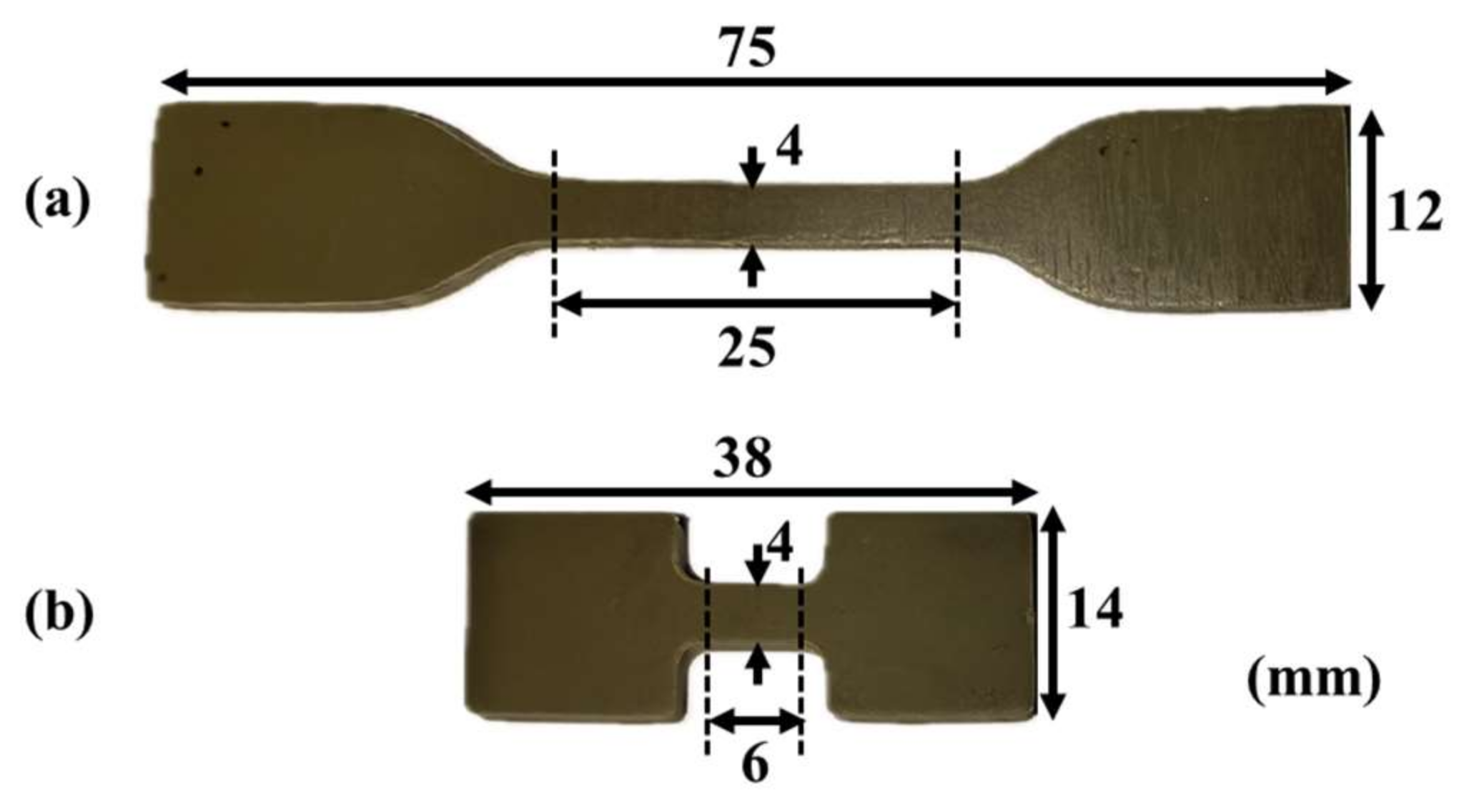

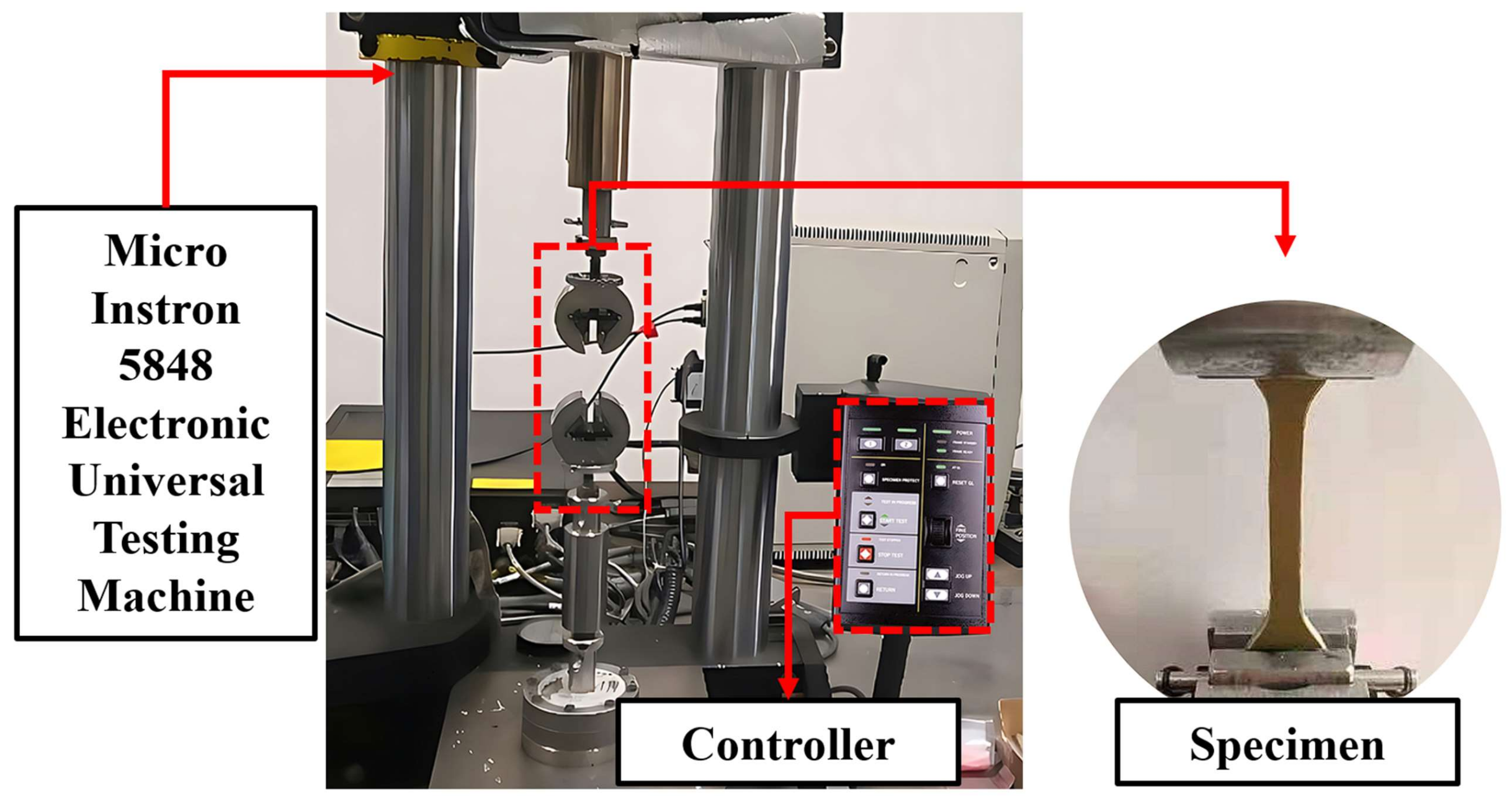

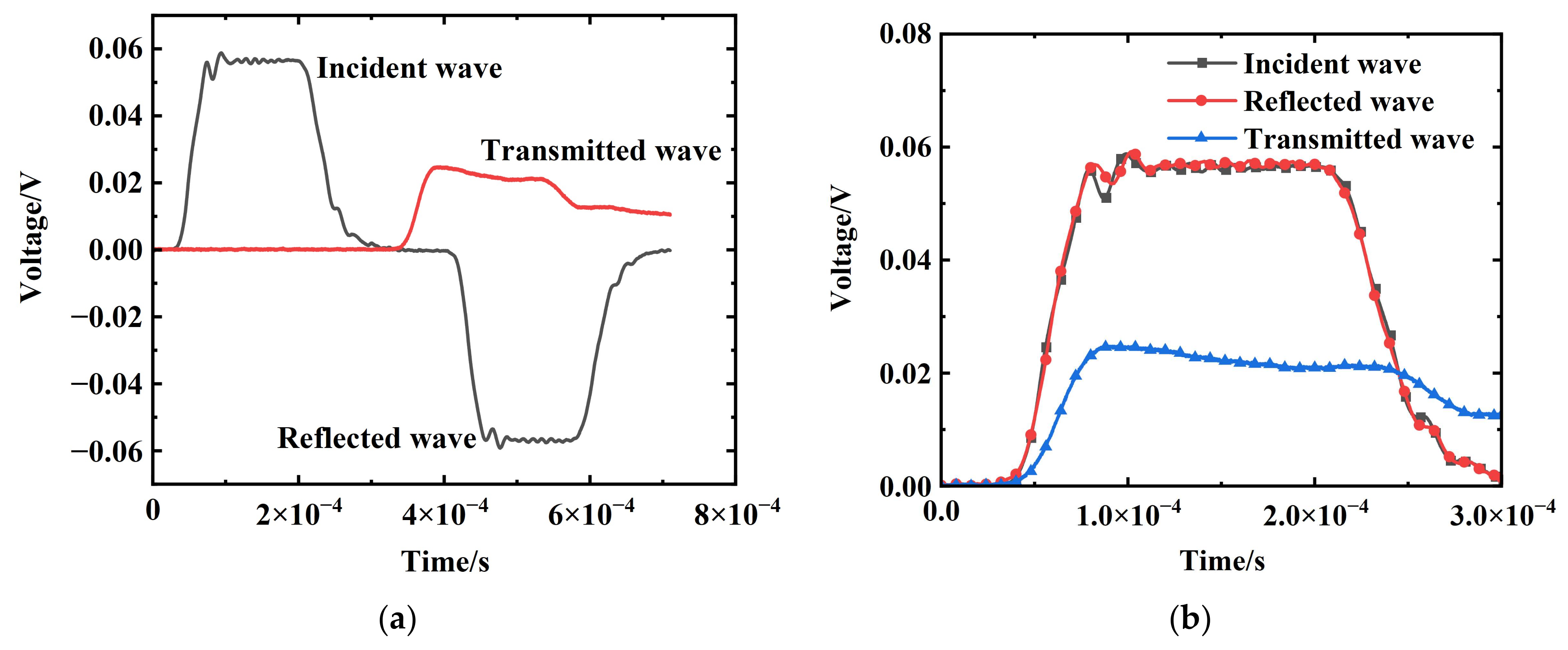
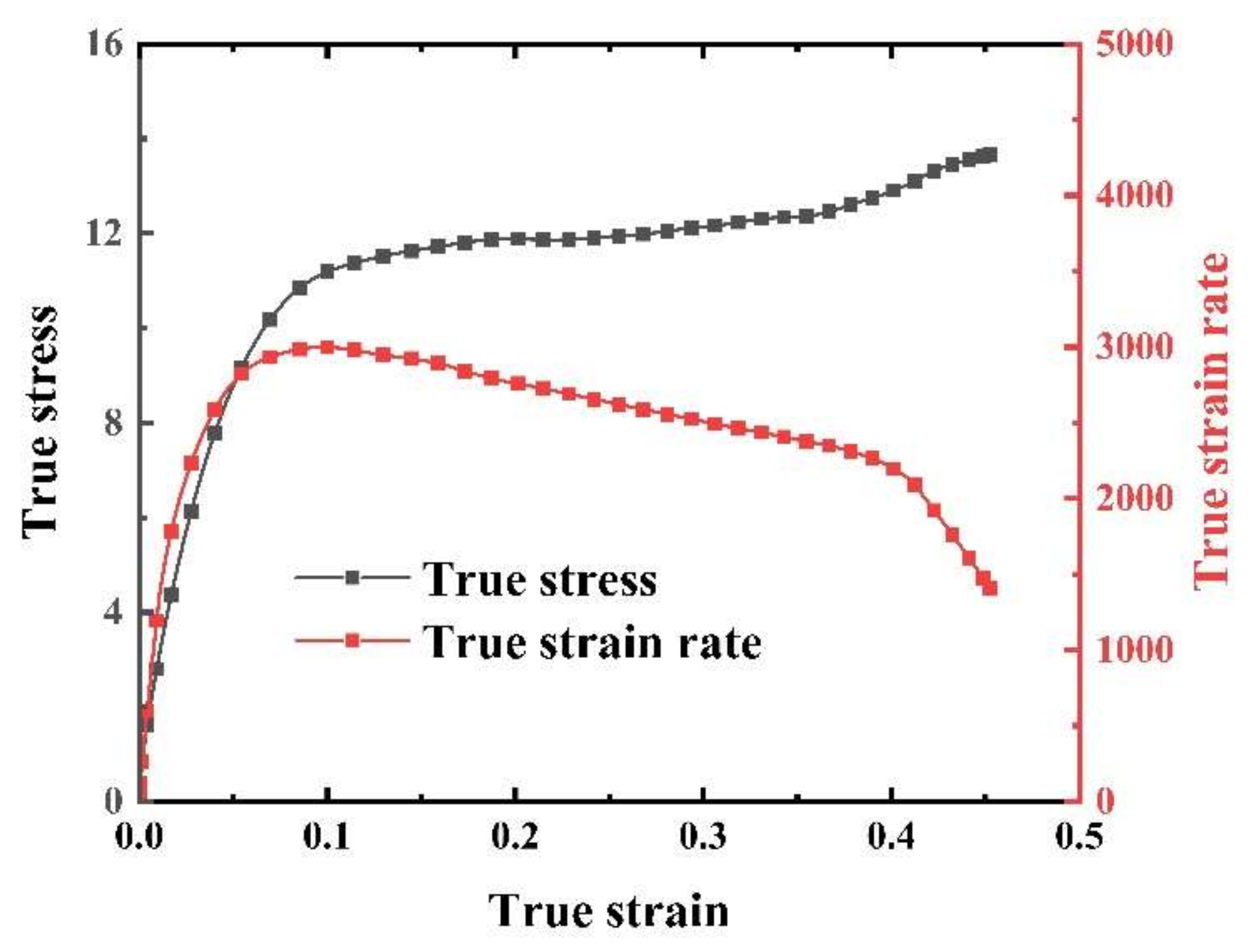
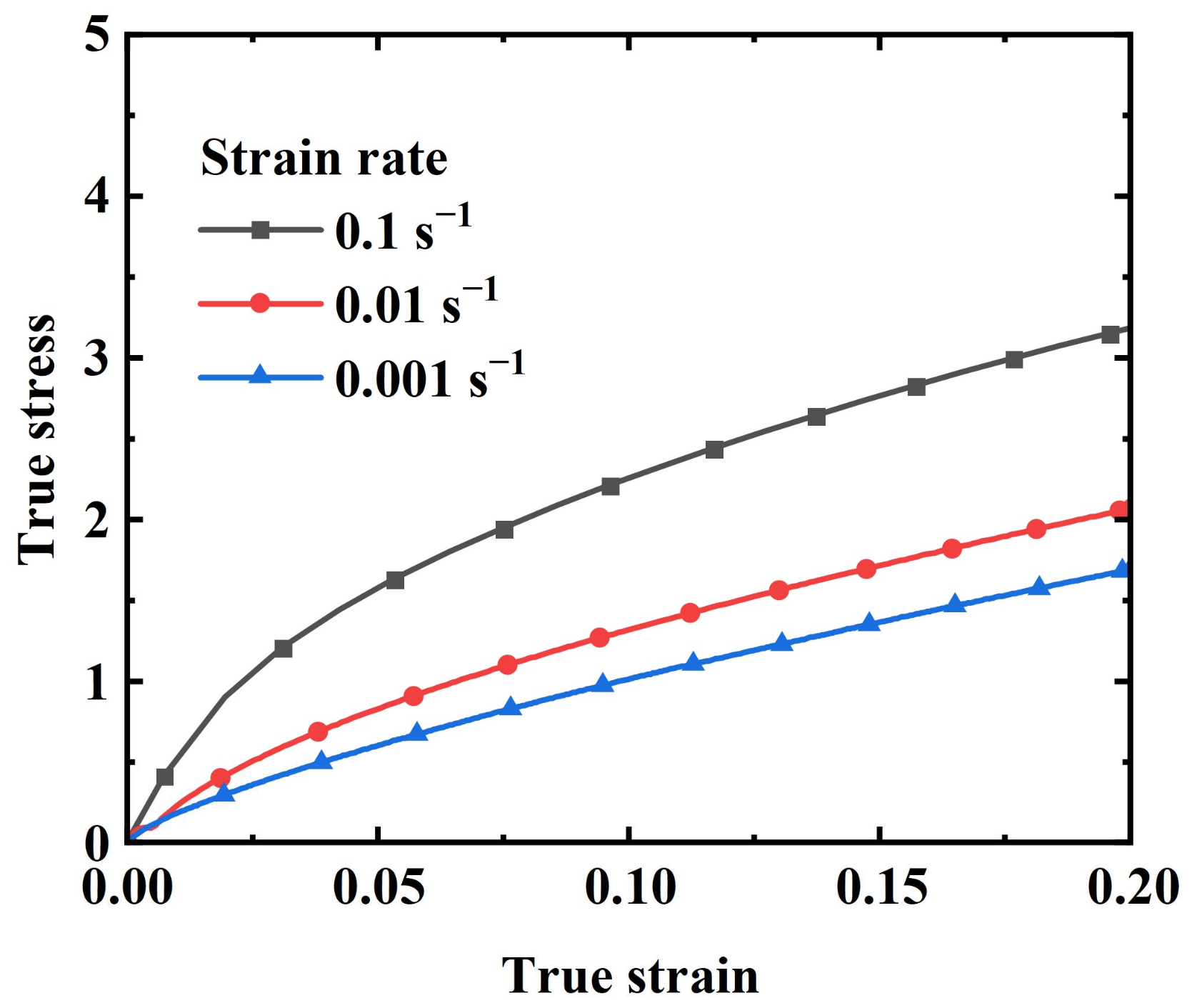



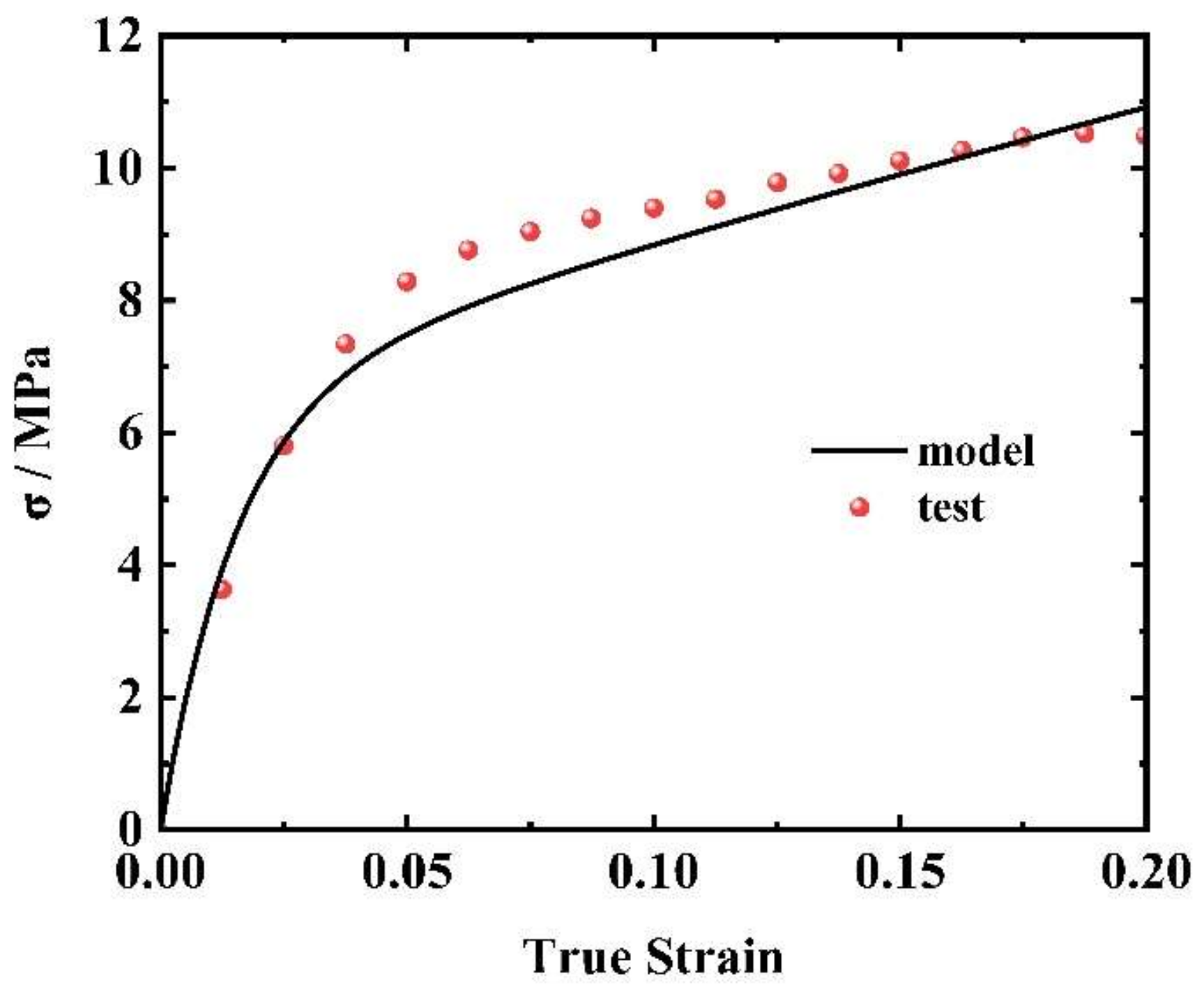
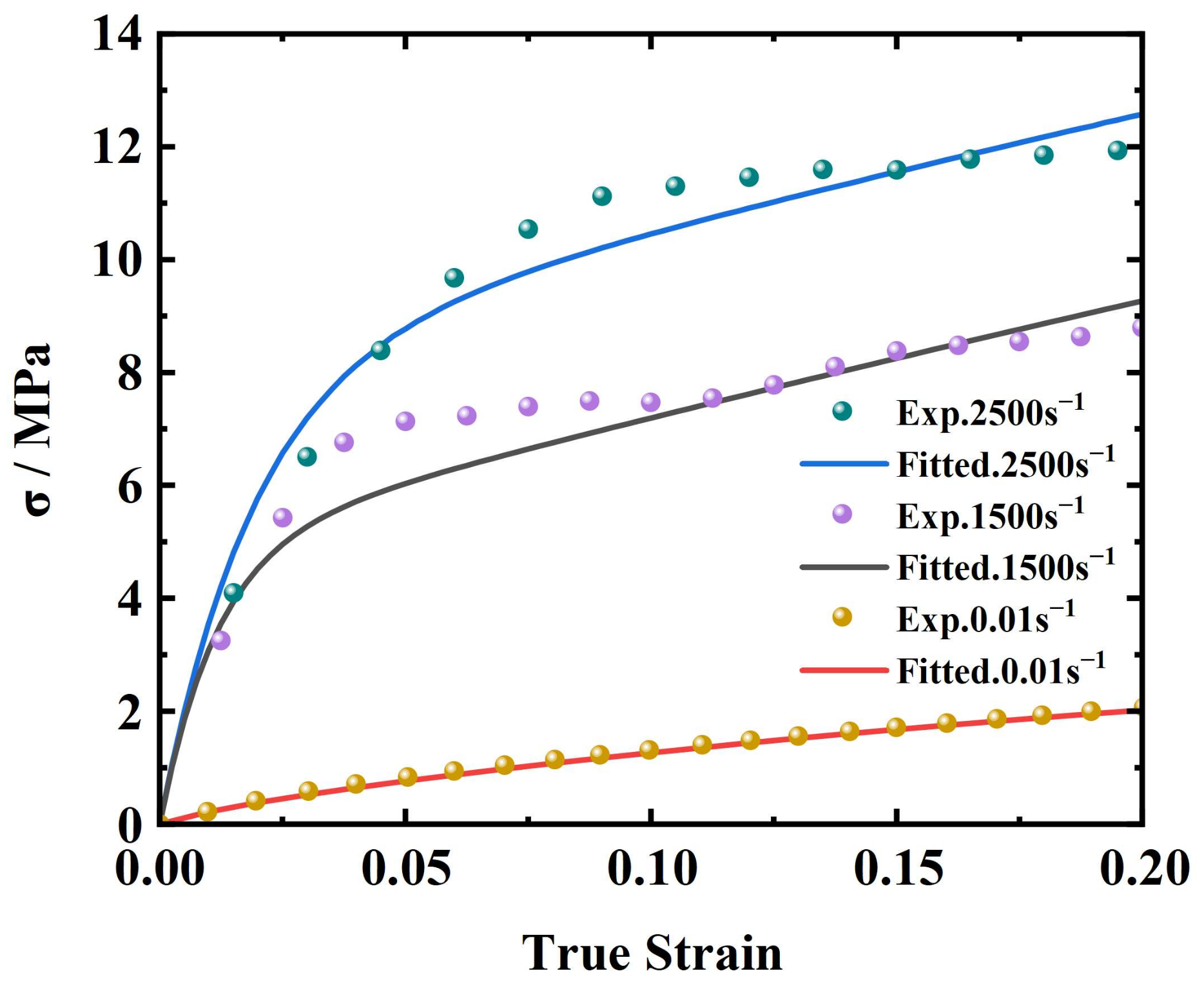
| Component | EPDM | Al(OH)3 | Flame Retardant | Processing Aid |
|---|---|---|---|---|
| Content (wt%) | 56 | 30 | 10 | 4 |
| Parameters | Striking Tube | Waveguide Bar | Incident Bar | Transmitted Bar |
|---|---|---|---|---|
| Material | TC4 | TC4 | TC4 | PMMA |
| Length/m | 0.6 | 2.5 | 1.7 | 2 |
| Diameter/mm | 27outer, 20inner | 19 | 14 | 14 |
| Modulus/MPa | 113,500 | 113,500 | 113,500 | 4774 |
| Wave speed/m/s | 4966 | 4966 | 4966 | 2110 |
| E1 | θ1 | α1 | μ1 | α2 | μ2 | α3 | μ3 | E2 | θ2 |
|---|---|---|---|---|---|---|---|---|---|
| 12.35 | 1.19 | −5.57 | 6.31 | −2.98 | 0.75 | −8.34 | −3.51 | 425.63 | 7.78 × 10−6 |
Disclaimer/Publisher’s Note: The statements, opinions and data contained in all publications are solely those of the individual author(s) and contributor(s) and not of MDPI and/or the editor(s). MDPI and/or the editor(s) disclaim responsibility for any injury to people or property resulting from any ideas, methods, instructions or products referred to in the content. |
© 2024 by the authors. Licensee MDPI, Basel, Switzerland. This article is an open access article distributed under the terms and conditions of the Creative Commons Attribution (CC BY) license (https://creativecommons.org/licenses/by/4.0/).
Share and Cite
Wang, R.; Zhang, Y.; Wang, N.; Wu, Y. Rate-Dependent Tensile Properties of Aluminum-Hydroxide-Enhanced Ethylene Propylene Diene Monomer Coatings for Solid Rocket Motors. Materials 2024, 17, 3790. https://doi.org/10.3390/ma17153790
Wang R, Zhang Y, Wang N, Wu Y. Rate-Dependent Tensile Properties of Aluminum-Hydroxide-Enhanced Ethylene Propylene Diene Monomer Coatings for Solid Rocket Motors. Materials. 2024; 17(15):3790. https://doi.org/10.3390/ma17153790
Chicago/Turabian StyleWang, Ran, Yiming Zhang, Ningfei Wang, and Yi Wu. 2024. "Rate-Dependent Tensile Properties of Aluminum-Hydroxide-Enhanced Ethylene Propylene Diene Monomer Coatings for Solid Rocket Motors" Materials 17, no. 15: 3790. https://doi.org/10.3390/ma17153790





